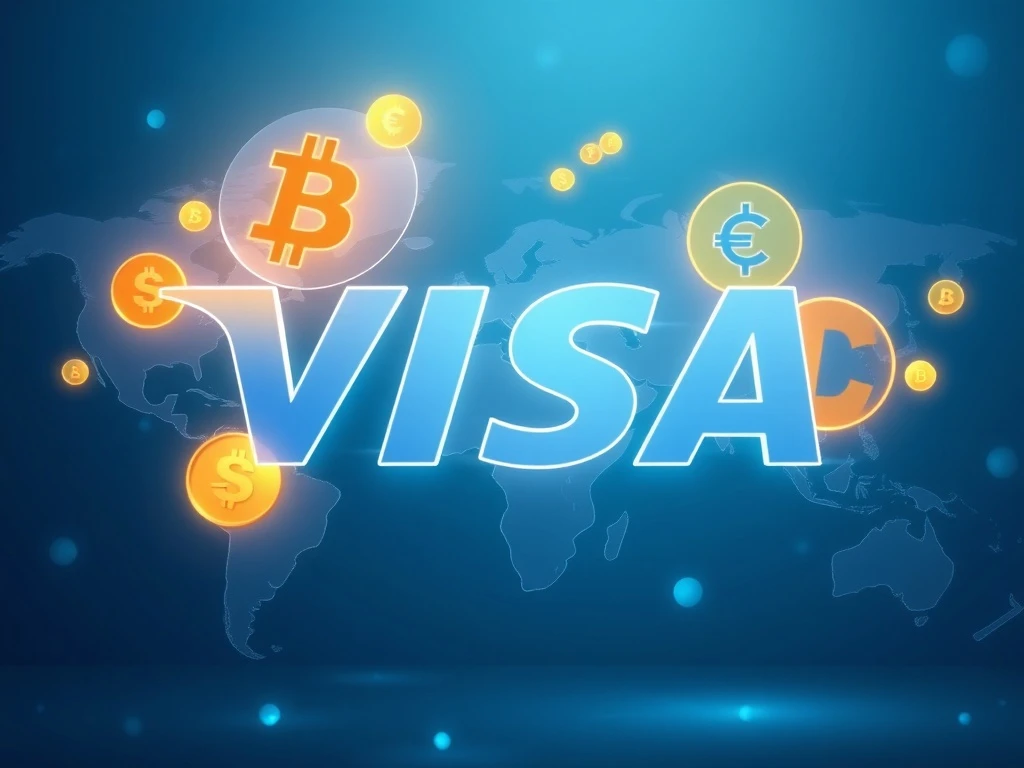Revolutionary Stablecoins: Visa Direct Transforms Global Payments

The world of finance constantly evolves, and stablecoins are at the forefront of this transformation. For those immersed in cryptocurrencies, the news is significant: Visa is actively testing stablecoins as a cash equivalent for instant transfers. This groundbreaking initiative, centered on its Visa Direct platform, aims to modernize treasury operations and streamline cross-border payments. This development signals a major step towards mainstream adoption of digital assets within traditional financial systems.
Visa Direct Pilots Stablecoins for Instant Global Transfers
Visa has officially launched a pilot program utilizing stablecoins to facilitate real-time cross-border payouts. This strategic move employs Circle’s USDC and EURC, treating these digital assets as cash equivalents for initiating instant transfers. Announced at SIBOS 2025, the Visa Direct stablecoin pilot allows select banks and financial institutions to pre-fund international payments using these stable assets. This innovation seeks to dramatically reduce the reliance on outdated systems.
Chris Newkirk, president of commercial and money movement solutions at Visa, highlighted the critical need for this change. He stated, “Cross-border payments have been stuck in outdated systems for far too long.” The primary objective involves reducing the need for capital to be parked in advance. Furthermore, it aims to modernize treasury operations globally. “Visa Direct’s new stablecoins integration lays the groundwork for money to move instantly across the world, giving businesses more choice in how they pay,” Newkirk added. This approach promises greater efficiency and flexibility for participating institutions.
Optimizing Liquidity with USDC and EURC
The pilot program specifically targets banks, remittance services, and financial institutions looking to optimize their liquidity management. Instead of tying up significant fiat currencies across multiple international corridors, participants can now fund Visa Direct with stablecoins. Visa views these digital assets as equivalent to cash for the purpose of initiating payouts. This methodology unlocks working capital, offering a significant advantage.
Key benefits of this stablecoin pre-funding model include:
- **Enhanced Working Capital:** Funds are not locked in traditional banking systems.
- **Reduced Currency Volatility Exposure:** Stablecoins minimize risks associated with fluctuating fiat exchange rates.
- **Improved Predictability:** Treasury flows become more consistent, even during off-hours or weekends.
This approach allows financial institutions to maintain more agile and responsive treasury operations. The stablecoin market cap currently exceeds $307 billion, indicating a robust and growing ecosystem. Visa has already settled over $225 million in stablecoin volume to date. While this remains a small fraction of its $16 trillion in annual payments, it demonstrates tangible progress and potential. The pilot is currently limited to partners meeting Visa’s internal criteria, with broader rollout plans slated for 2026.
Transforming Cross-Border Payments with Digital Assets
The integration of stablecoins into Visa’s payment infrastructure represents a significant leap forward for cross-border payments. Traditional systems often involve multiple intermediaries, high fees, and slow settlement times. Stablecoins, however, offer a more direct and efficient pathway for value transfer. This can lead to faster transactions and lower operational costs for businesses and consumers alike. The move by Visa also validates the growing utility of digital currencies beyond speculative trading.
For example, companies conducting international business often face delays and complexities when paying suppliers or employees in different countries. By leveraging USDC or EURC, these businesses can facilitate near-instant settlements. This drastically improves cash flow management and operational efficiency. Furthermore, the 24/7 nature of stablecoin transactions overcomes the limitations of traditional banking hours. This ensures that payments can be processed anytime, anywhere, regardless of time zones or public holidays.
The Competitive Landscape: Crypto Payments and Traditional Finance
Visa’s entry into stablecoin-powered crypto payments comes amidst a broader industry shift. Traditional financial giants and innovative startups are all exploring blockchain technology for global settlements. For instance, just recently, SWIFT announced a collaboration with Ethereum developer Consensys and over 30 financial institutions. Their goal is to build a blockchain-based settlement platform enabling 24/7 real-time cross-border payments. This initiative highlights the increasing pressure on established players to adapt to new technologies.
The crypto payment sector itself is experiencing rapid growth and investment. Last week, stablecoin payments startup RedotPay achieved unicorn status, raising $47 million in a strategic round led by Coinbase Ventures. Galaxy Ventures and Vertex Ventures also supported this round. Similarly, stablecoin infrastructure startup Bastion secured $14.6 million in funding. This round was led by Coinbase Ventures, with backing from major players like Sony, Samsung Next, Andreessen Horowitz, and Hashed. These investments underscore the market’s confidence in the future of digital currency-based payment solutions.
The Future of Global Transfers with Visa Direct
Visa’s stablecoin pilot with Visa Direct marks a pivotal moment in the evolution of global financial infrastructure. By embracing digital assets, Visa is positioning itself at the forefront of innovation in the payments industry. This move could set a new standard for speed, efficiency, and cost-effectiveness in international money movement. As the pilot expands, it will likely pave the way for broader adoption of stablecoins across various financial services.
This initiative also aligns with a global trend towards digital currencies, including central bank digital currencies (CBDCs). While stablecoins are distinct from CBDCs, their successful integration into mainstream payment networks demonstrates the viability of digital assets for everyday financial transactions. Visa’s strategic decision to leverage USDC and EURC reflects a proactive approach to staying competitive and relevant in a rapidly changing financial landscape. Ultimately, this will benefit businesses and individuals requiring efficient and reliable cross-border payment solutions.







